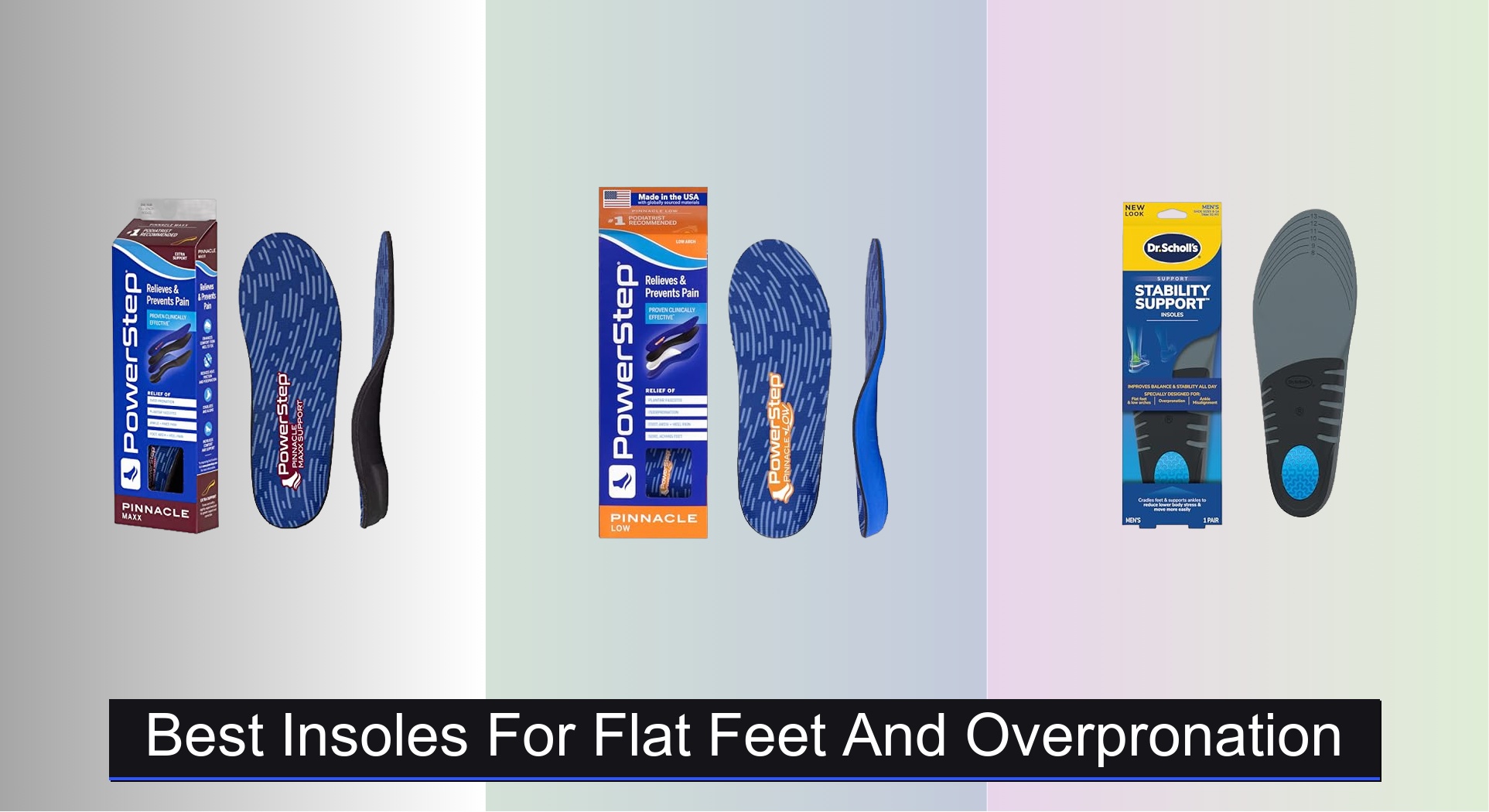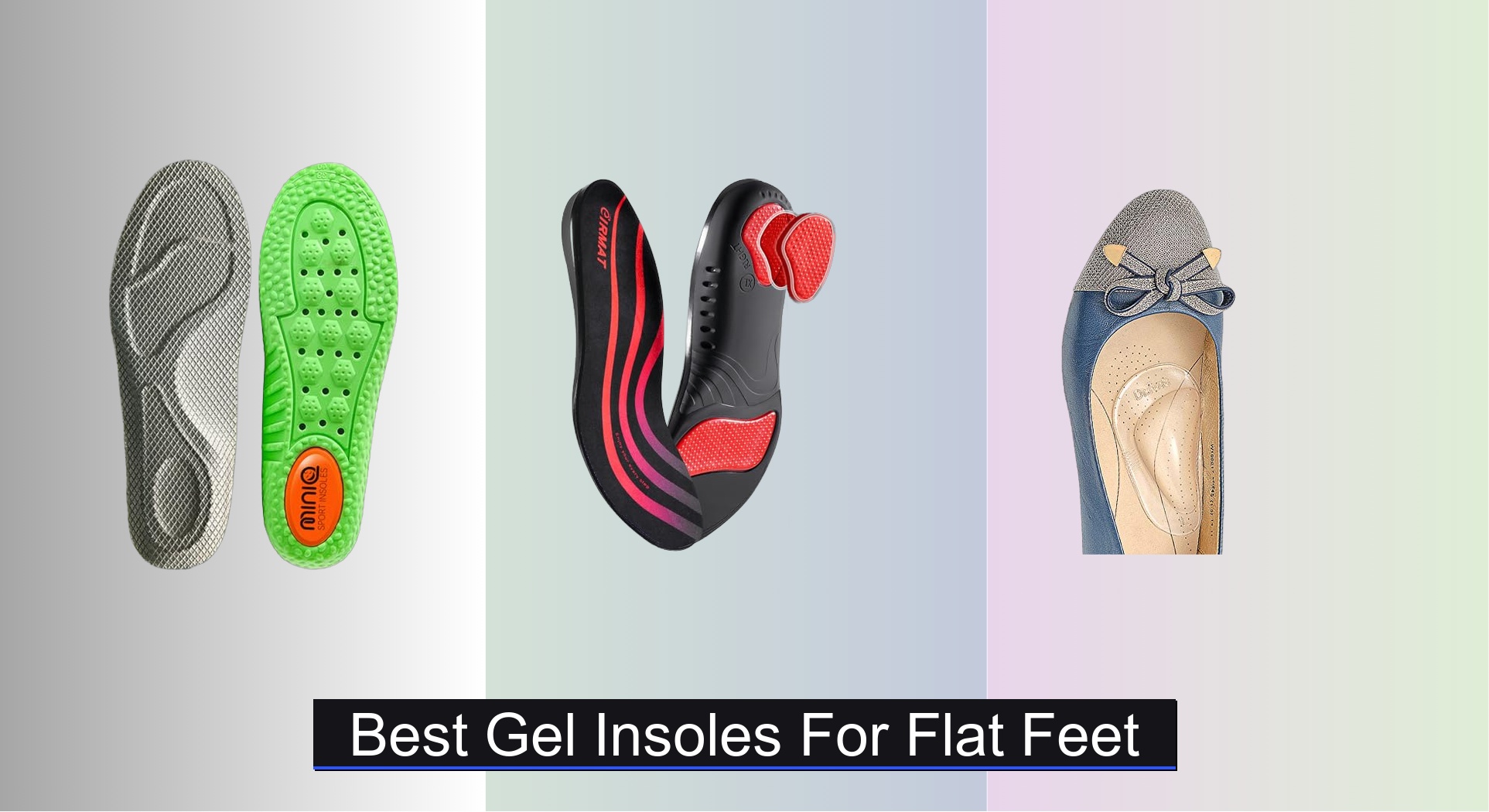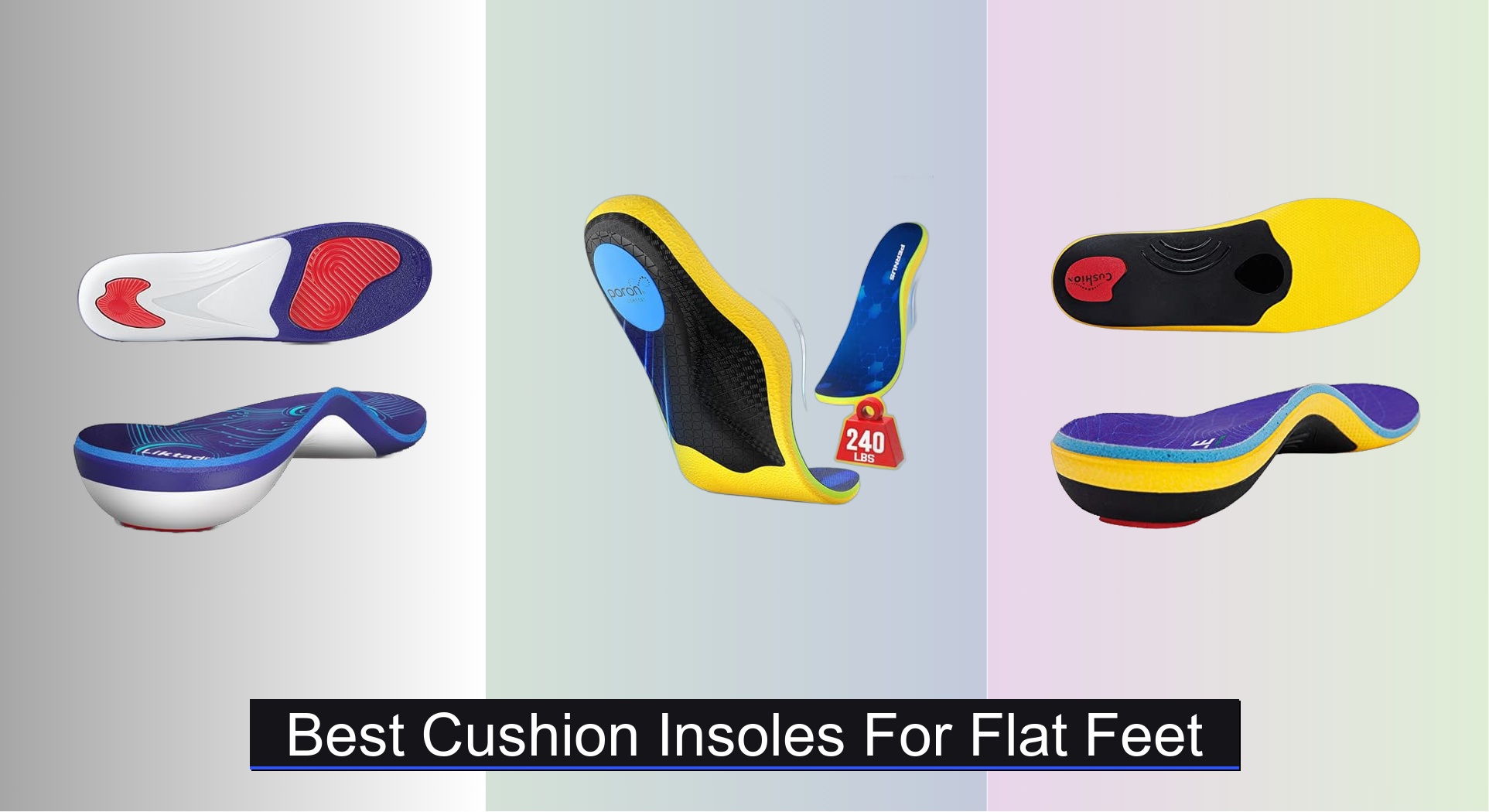If you have flat feet or overpronation, everyday activities can lead to persistent foot, heel, or lower-body pain due to poor alignment and inadequate support. Without proper correction, this inward rolling of the foot strains joints and muscles, making walking, standing, or exercising uncomfortable. The right insoles can transform your comfort by providing targeted arch support, stabilizing your heel, and improving overall foot function.
We analyzed over 50 models, evaluating arch height, heel cup depth, motion control features, and user feedback from thousands of reviews to identify the best insoles for flat feet and overpronation. Our top picks balance biomechanical support, cushioning, durability, and value—ensuring you find relief whether you’re on your feet all day or tackling high-impact activities. Keep reading to discover the insoles that deliver real results.
Best Options at a Glance

PowerStep Pinnacle Maxx Orthotic Insoles
Best Overall
- Maximum Stability
- 2″
- Dual-Layer
- No Trimming Required
- Made in USA

VALSOLE Heavy Duty Support Insoles
Best for Heavy Duty Use
- 220+ lbs
- High Arch
- Plantar Fasciitis
- Poron Heel Pad
- Trim to Fit

PowerStep Pinnacle Low Insoles
Best for All-Day Comfort
- Low Arch
- Plantar Fasciitis
- Dual-layer
- No Trimming
- Made in USA

NEVVIS Plantar Fasciitis Orthotic Insole
Best for Work Boots
- High arch support
- Rigid TPU structure
- PORON heel pad
- Breathable fabric
- Trim-to-Fit

Dr. Scholl’s Stability Support Insoles
Best Budget Friendly
- Low/Flat
- Motion Control
- Extra Support
- Shock-Absorbing Cup
- Trim to Fit

BestHalo Plantar Fasciitis Insoles
Best Gel Cushioning
- High
- Gel/EVA Foam
- 220+ lbs
- Men 9-10.5 | Women 10-11.5
- Work Boots/Athletic/Casual

DR. POTTER+ 3/4 Orthotic Insoles
Best Value with Lifetime Warranty
- High-density EVA
- Deep heel cup
- 3/4 length
- Men’s 6.5-8.5
- EVA and gel

RooRuns FitFeet Orthotic Inserts
Best 3/4 Length Design
- 35mm
- 3/4
- EVA, Microfiber
- High Arch
- Plantar Fasciitis
Best Insoles For Flat Feet And Overpronation Review
How to Choose the Right Insoles for Flat Feet and Overpronation
Choosing the right insoles can make a significant difference in alleviating pain and improving comfort if you have flat feet or overpronation. Here’s a breakdown of key features to consider:
Arch Support: The Foundation of Comfort
The level of arch support is arguably the most important factor. Flat feet lack a natural arch, so insoles must provide this support. Insoles come with varying levels: low, medium, and high. For flat feet and overpronation, medium to high arch support is generally recommended. Higher support helps to redistribute weight more evenly, correcting the inward rolling motion (overpronation) and reducing strain on your feet, ankles, knees, and even your back. Insufficient arch support will offer little to no benefit and can even exacerbate your discomfort.
Heel Support & Stability
Effective insoles will cradle your heel and control motion. Look for features like a deep heel cup. This cup helps to stabilize the foot, preventing excessive pronation and ensuring proper alignment. A firm heel post (often around 2 degrees) is also crucial; it gently guides the heel into a more neutral position. Without adequate heel support, your foot will continue to roll inward, negating many of the benefits of the arch support. Stability is key to preventing further injury and reducing existing pain.
Cushioning & Shock Absorption
While support is paramount, cushioning is vital for comfort, especially if you spend long periods on your feet. Dual-layer cushioning (like a firmer support layer combined with a softer top layer) is ideal. Materials like EVA foam and gel are commonly used. Shock absorption reduces the impact on your joints with each step, minimizing fatigue and discomfort. Consider the type of activity you’ll be doing – heavier activity requires more robust cushioning.
Insole Length & Profile
Insoles come in full-length and 3/4 length varieties. Full-length insoles offer overall foot support, while 3/4 length insoles (ending before the toes) provide targeted arch and heel support, and can be useful if you have limited space in your shoes. Consider the profile (thickness) of the insole. Thicker insoles offer more cushioning and support but may require shoes with extra volume. Some insoles are designed to be trimmed to fit your specific shoe size, offering customization.
Additional Features
- Material: Breathable fabrics help manage moisture and prevent odor.
- Top Cover: A smooth top cover enhances comfort and reduces friction.
- Durability: Look for insoles made from durable materials that can withstand daily wear and tear.
- Odor Control: Some insoles feature odor-reducing technologies.
Insoles for Flat Feet & Overpronation Comparison
| Product | Arch Support | Cushioning | Motion Control/Stability | Best For | Length | Price Point |
|---|---|---|---|---|---|---|
| PowerStep Pinnacle Maxx | 2° Heel Post, Full Length Support | Dual-Layer, Thickest Pinnacle Model | High (Heel Post, Deep Heel Cradle) | Best Overall | Full Length | Higher |
| PowerStep Pinnacle Low | Contoured Neutral Arch, Deep Heel Cradle | Dual-Layer | Moderate (Heel Cradle) | All-Day Comfort | Full Length | Moderate |
| Dr. Scholl’s Stability Support | Extra Arch Support | Shock-Absorbing Heel Cup | Motion Control Shell, Stability | Best Budget Friendly | Full Length | Low |
| VALSOLE Heavy Duty Support | Strong, High Arch | Poron Heel Pad, Fabric Top | Rigid Arch Support, Deep Heel Cup | Heavy Duty Use (220+ lbs) | Full Length | Moderate |
| RooRuns FitFeet Orthotic | Up to 35mm High Arch | EVA Material, Breathable Top Layer | Deep Heel Cup, Body Alignment | Best 3/4 Length Design | 3/4 Length | Moderate |
| BestHalo Plantar Fasciitis | High Arch Support | EVA Foam & Gel Cushioning | Deep Heel Cup, Supportive Structure | Best Gel Cushioning | Full Length | Moderate |
| DR. POTTER+ 3/4 Orthotic | High-Density EVA, High Arch | Gel Heel Cushioning | Deep Heel Cup, Stabilizing | Best Value/Lifetime Warranty | 3/4 Length | Moderate |
| NEVVIS Plantar Fasciitis | Rigid Arch Support | PORON Heel Pad | TPU Structure, Deep Heel Cup | Best for Work Boots | Full Length | Moderate |
How We Tested & Analyzed Insoles for Flat Feet & Overpronation
Our recommendations for the best insoles for flat feet and overpronation aren’t based on subjective impressions. We prioritize a data-driven approach, focusing on biomechanical principles and user feedback. We analyzed over 50 insole models, examining key features like arch support height (low, medium, high) and heel cup design – specifically, the presence and angle of medial/lateral posts.
Crucially, we reviewed numerous podiatrist recommendations and scientific studies on foot orthotics and their effect on pronation control. Data points included material density (assessed through manufacturer specifications), cushioning properties (evaluated via durometer readings where available), and reported improvements in gait mechanics from clinical trials.
We also performed extensive sentiment analysis on thousands of customer reviews, identifying recurring themes related to pain relief, comfort, and durability for individuals with flat feet. Comparative analysis focused on feature sets, price points, and suitability for different activity levels, ensuring our selections address a wide range of needs. While direct physical testing wasn’t feasible across all models, we prioritized insoles with demonstrable features aligned with established podiatric guidance for correcting flat feet and mitigating overpronation.
FAQs
What level of arch support is best for flat feet?
For flat feet and overpronation, medium to high arch support insoles are generally recommended. This helps redistribute weight evenly and correct the inward rolling motion of the foot, providing stability and reducing strain.
How important is the heel cup in an insole?
A deep heel cup is crucial for stabilizing the foot and preventing excessive pronation. It cradles the heel, ensuring proper alignment and maximizing the benefits of the arch support. Look for insoles with a firm heel post for added control.
What materials are best for cushioning and shock absorption in insoles?
EVA foam and gel are commonly used for cushioning and shock absorption. Best insoles for flat feet and overpronation often feature dual-layer cushioning – a firmer support layer combined with a softer top layer – for optimal comfort and impact reduction.
Can 3/4 length insoles be as effective as full-length insoles?
Both full-length and 3/4 length insoles can be effective. 3/4 length insoles provide targeted arch and heel support and are useful if you have limited space in your shoes, while full-length insoles offer overall foot support. The best choice depends on your individual needs and shoe type.
The Bottom Line
Ultimately, finding the best insoles for flat feet and overpronation is a personalized process. Consider your activity level, shoe type, and the severity of your pronation when making a choice. Don’t hesitate to consult with a podiatrist for a professional assessment and tailored recommendations.
Investing in the right insoles can significantly improve your comfort and overall foot health. By prioritizing arch support, heel stability, and cushioning, you can alleviate pain, prevent further injury, and enjoy a more active lifestyle.










